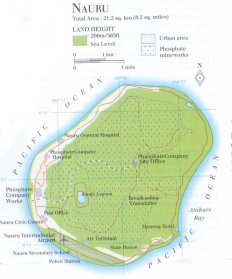 | NAURUgeneral data of the country |
| General useful information |
| Note: some data are of constant value, while other are due to changes, fluctuations etc. |
| Nation and population |
| official name (short form): Nauru |
| country code ISO: NR //; - FIPS: NR |
| location: Western Pacific Ocean |
| time zone: +12 UT |
| surface (land) area: 21,3 sq.km = 8.2 sq.mi //; - area incl. inland waters: sq.km = sq.mi |
| geographical position in extreme co-ordinates: North/South: 1° S / East/West: 167° W |
| borders (land): none |
| borders (coastline): Pacific Ocean |
| climate: tropical oceanic |
| Government |
| independent since: 1968-01-31 |
| type of government: republic |
| capital: Yaren |
| administrative division: none, or unknown |
| Population |
| population according to the latest census (1992): 9,919 |
| total population according to the estimate of midyear 2000: 11,845 /-; 2001: 12,088 |
| population density: 559 per sq.km = 1447 per sq.mi |
| population growth: 2,5% //; - doubling time: ca 30 years |
| birth rate: 23 - 27 per 1000 |
| death rate: 5 -7 per 1000 |
| fertility rate: 2 children per female |
| maternal mortality: per 100,000 |
| infant mortality (1-4 years): 41 per 1000 |
| life expectancy: 62 - 66,5 years (male: 58 - 64; female: 65 - 69) |
| age breakdown: 0-14 years: 42% //; - 15-59 years: 55% //; - 60+ years: 3% |
| urbanisation: 100% //; - urbanisation growth: % |
| percentage of urban population in the greatest city: 100 (?)% |
| Ethnic composition, language, religion |
| ethnic groups: Nauruan 58 - 61%; other Pacific groups 26%; Chinese 8%; European 3 - 8% |
| languages: Nauruan (official); English |
| religious affiliation: Protestant 51%; Roman Catholic 27%; other 22% |
| Health |
| daily food intake: 3011 calories per capita |
| population with access to safe water: % |
| people per physician: 700 |
| people per hospital bed: |
| Education, literacy |
| school enrolment: primary education 6-11 years: % |
| school enrolment: secondary education: % |
| school enrolment: tertiary education 20-24 years: % |
| adult literacy: 99% (male: %; female: %) |
| Economy and infrastructure |
| Economy and trade |
| currency: Australian dollar = 100 cents |
| annual inflation rate: 7% |
| population below poverty line: % |
| Gross Domestic Product: USD per capita |
| GNI USD per capita //; - [ppp: 7210] |
| GDP growth: 2% |
| income: USD 10000 per capita |
| import: USD 18 per capita //; - export: USD 29 per capita |
| trade: USD 18000 per capita //; - or % of GDP |
| trade partners: AU NZ |
| human development index: //; - position of the country in the world no.: |
| female labour force: % |
| unemployment: % |
| tourism: million |
| Economic activities in agriculture, fisheries, industry, mining, services, energy |
| land use: arable land: % //; - grass land: % //; - wooded area: % //; - arid land and desert: % |
| agriculture: labour force: % //; - part of agriculture in GDP: % |
| agricultural products: coconuts, fishing |
| livestock (1000s): pigs: 3 / poultry: 5 |
| fish catch: metric tonnes |
| industry: labour force: % //; - part of industry in GDP: % |
| industrial products: of no importance |
| mining products: phosphate (source is practically exhausted) |
| CO2 emission per capita: |
| services: labour force: % //; - part of services in GDP: % |
| energy use (kg per capita): 443 |
| electricity use (per capita): |
| annual water use (per capita): |
| Traffic, communication |
| road network: 28 km //; - of which paved: 79% //; - of which are motorways: 0 km |
| vehicles: 159 per 1000 |
| railways: 5 km //; - railways passenger/km: ? |
| navigable inland waterways: 0 km |
| ownership telephone: 149 - 193 per 1000 |
| ownership radio receivers: 385 - 609 per 1000 |
| ownership tv-sets: 46 per 1000 |
| newspaper circulation: per 1000 |
| persons per post office: 406 |
| personal computers: per 1000 |
| Some physical landmarks |
| mountains: none, or unknown |
| lowest point: sea level |
| lakes (natural): Buada Lagoon |
| lakes (artificial reservoirs): none, or unknown |
| lakes (deepest): Buada Lagoon (?) |
| rivers: none, or unknown |
| canals: none, or unknown |
| waterfalls: none, or unknown |
| caves: longest system: none, or unknown / deepest: |
| islands: except for the island of Nauru itself: none |
| deserts: none |
| other natural features: |
| Additional remarks, especially on the statistical information |
| other important features: |
| apart from physical landmarks most of the above figures are changeable, in most cases they date from the 1990's |
| primary sources used for the general information: |
| BB CA EV PW WA WB WR, and some national statistical yearbooks |
| particulars concerning population data: |
 To the page containing the population growth statistics of the country
To the page containing the population growth statistics of the country
 To the page containing some information of the places on the island
To the page containing some information of the places on the island
 Back to the homepage of this website: POPULATION STATISTICS
Back to the homepage of this website: POPULATION STATISTICS
Latest modification of this page on 2004-02-28 by Jan Lahmeyer
© "populstat" site: Jan Lahmeyer